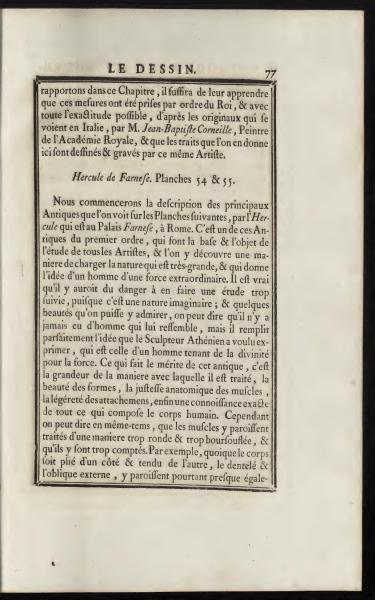THE DRAWING.
We mention in this Chapter, it will suffice to teach them that these measurements were taken by order from the King, and with the utmost precision possible, according to the originals found in Italy, by Mr. Jean-Baptiste Corneille, Painter of the Royal Academy, and that the strokes provided here are drawn and engraved by the same Artist.
Farnese Hercules. Plates 54 & 55.
We will begin the description of the main ancient sculptures seen on the following Plates, with the Hercules found at the Farnese Palace, in Rome. It is one of those eminent ancient works which form the foundation and focus of study for all Artists, and one discovers in it a manner of enhancing nature to a very high degree, which conveys the idea of a man with extraordinary strength. It is true that there would be danger in making too concentrated a study of it, as it represents an imaginary nature; and although one can admire certain beauties in it, one might say there has never been a man who resembles it, but it perfectly fulfills the idea the Athenian Sculptor wanted to express, that of a man embodying divine strength. What makes the merit of this antique piece is the grandeur of the manner in which it is treated, the beauty of the forms, the anatomical accuracy of the muscles, the lightness of attachments, and a precise understanding of all that makes up the human body. However, it can also be said that the muscles appear treated in a manner that is too round and too swollen, and that they are too counted. For example, even though the body is bent on one side & stretched on the other, the serratus and the external oblique appear almost equally prominent.
Translation Notes
- "l'idée d'un homme tenant de la divinité" suggests "embodying divine strength," another interpretation might be "reflecting divine qualities."
- "comptés" literally means "counted," but in this context indicates "exaggerated" detailing.
The text discusses the proportions and merits of the Farnese Hercules, a classical statue, emphasizing its role as an exemplary model for artists. The statue represents an idealized human form with divine strength, though its muscles are considered somewhat exaggerated. The notes include a historical context, with the original work by Jean-Baptiste Corneille for the Royal Academy.
